Overview
When you have an ACL injury, you lose leg strength and motion. You also lose stability in your knee. It's important to get back your leg strength and motion as soon as you can, whether you choose to have surgery or not. Exercises to get back your muscle strength and knee motion should begin before you start treatment, whether treatment is a rehabilitation (rehab) program only or surgery plus rehab.
- After an ACL injury, your knee won't be stable. It may be painful and may have a limited range of motion. Later, you may have osteoarthritis in the knee.
- If you do exercises to strengthen your thigh muscles (quadriceps and hamstrings) and get back your knee motion soon after your injury, you will be better prepared for a rehab program or for surgery and a rehab program.
- Start slowly. And slowly increase the intensity of the exercises. Don't push yourself to the point that you feel pain. Talk to your doctor about how to best progress through the exercises.
Check with your doctor before you do any exercises.
How do you do ACL exercises?
After an ACL injury, you might start with a few exercises, such as quad sets, hip flexion exercises, and heel slides. As symptoms decrease and you are able to bear weight, you might do other exercises, such as hip abduction exercises, glute sets, bridging, shallow standing knee bends, heel raises, and hamstring curls.
Your doctor may want you to tailor exercises to your specific injury. Check with your doctor before you do any exercises.
Start slowly. And slowly increase the intensity of the exercises. Don't push yourself to the point that you feel pain. Talk to your doctor about how to best progress through the exercises.
How to do the exercises
Bridging (heel dig)

- Lie on your back with both knees bent and your ankles bent so that only your heels are digging into the floor. Your knees should be bent about 90 degrees.
- Tighten your belly muscles by pulling your belly button in toward your spine. Keep breathing normally and don't hold your breath.
- Push your heels into the floor, squeeze your buttocks, and lift your hips off the floor until your shoulders, hips, and knees are all in a straight line. Keep your hips level.
- Hold for about 6 seconds.
- Slowly lower your hips back to the floor.
- Repeat 8 to 12 times.
Glute set (knees straight)
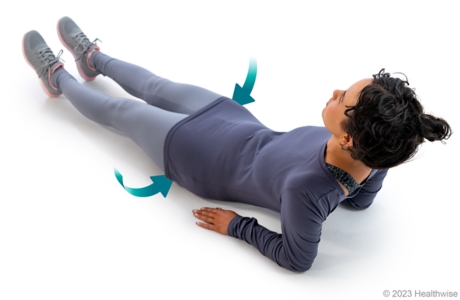
- Lie on your back and prop yourself up on your elbows.
- Squeeze your buttocks together as tightly as you can. Hold for about 6 seconds.
- Repeat 8 to 12 times.
Hamstring curl (lying down)
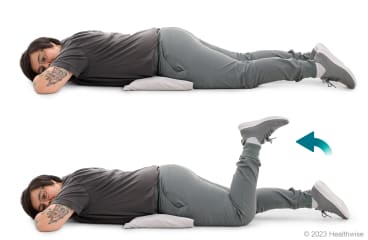
- Lie on your stomach with your legs straight.
- Lift the foot of your affected leg by bending your knee so that you bring your foot up toward your buttock. If this motion hurts, try it without bending your knee quite as far. This may help you avoid any painful motion.
- Slowly lower your foot back to the floor.
- Repeat 8 to 12 times.
- It's a good idea to repeat these steps with your other leg.
- If you're not comfortable, try placing a pillow under your stomach.
- If your kneecap is uncomfortable, roll up a washcloth and put it under your leg just above your kneecap.
When you can do this exercise with ease and no pain, add some resistance. To do this:
- Tie the ends of an exercise band together to form a loop. To hold the band in place, shut a door on the band so the knot is on the other side of the door, or attach one end of the loop to a secure object. (Or you can have someone hold one end of the loop to provide resistance.)
- Loop the other end of the exercise band around the lower part of your affected leg.
- Repeat steps 1 through 5, slowly pulling back on the exercise band with your leg.
Heel raise
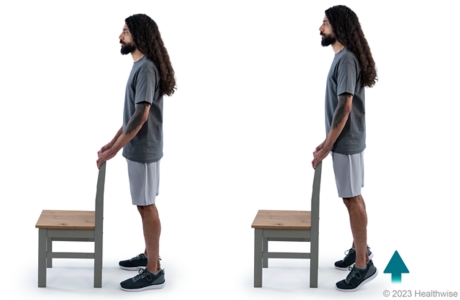
- Stand with your feet a few inches apart, with your hands lightly resting on a counter or chair in front of you.
- Slowly raise your heels 1 to 2 inches off the floor while keeping your knees straight. Hold for about 6 seconds, then slowly lower your heels to the floor.
- Repeat 8 to 12 times.
Heel slide
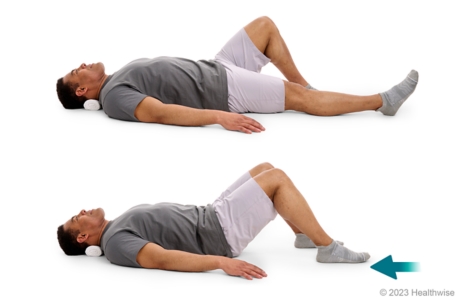
- Lie on your back with your affected leg straight. Bend your other leg.
- Slowly bend your affected leg by raising your knee up while sliding your foot toward you. Bend your knee as much as you can.
- Hold for about 6 seconds. Then slowly slide your foot away, lowering your leg back down.
- Repeat 8 to 12 times.
- It's a good idea to repeat these steps with your other leg.
Quad set

- Sit or lie down on a firm surface or the floor with your affected leg straight. Place a small, rolled-up towel under your knee.
- Tighten the thigh muscles of your straight leg by pressing the back of your knee down into the towel.
- Hold for about 6 seconds, then rest.
- Repeat 8 to 12 times.
- It's a good idea to repeat these steps with your other leg.
Shallow standing knee bend
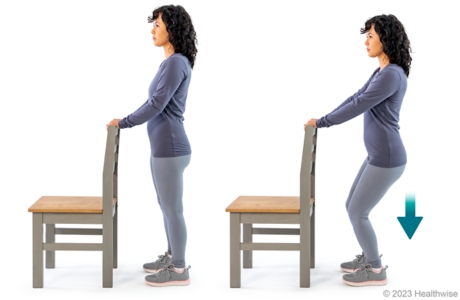
- Stand with your hands lightly resting on a counter or chair in front of you. Put your feet shoulder-width apart.
- Slowly bend your knees so that you squat down like you're going to sit in a chair. Make sure that your knees don't go in front of your toes.
- Lower yourself about 6 inches. Your heels should stay on the floor at all times.
- Rise slowly to a standing position.
- Repeat 8 to 12 times.
Hip flexion (lying down, leg straight)

- Lie on your back with your affected leg straight. You can bend your other leg, if that feels more comfortable.
- Tighten the thigh muscles in your affected leg by pressing the back of your knee down. Hold your knee straight.
- Keeping the thigh muscles tight and your leg straight, lift your affected leg up so that your heel is about 12 inches off the floor. Hold for about 6 seconds, then lower slowly.
- Repeat 8 to 12 times.
- It's a good idea to repeat these steps with your other leg.
Hip abduction (lying on side)

- Lie on your side, with your affected leg on top. You can use your hand or a pillow to support your head.
- Keep your knee straight and your leg in a straight line with your body.
- Lift your affected leg straight up toward the ceiling, about 12 inches off the floor. Hold for about 6 seconds, then slowly lower your leg.
- Repeat 8 to 12 times.
- It's a good idea to repeat these steps on your other side.
- Keep your kneecap pointing forward.
- Don't let your hip drop back.
Credits
Current as of: July 31, 2024
Author: Ignite Healthwise, LLC Staff
Clinical Review Board
All Healthwise education is reviewed by a team that includes physicians, nurses, advanced practitioners, registered dieticians, and other healthcare professionals.
Current as of: July 31, 2024
Author: Ignite Healthwise, LLC Staff
Clinical Review Board
All Healthwise education is reviewed by a team that includes physicians, nurses, advanced practitioners, registered dieticians, and other healthcare professionals.

